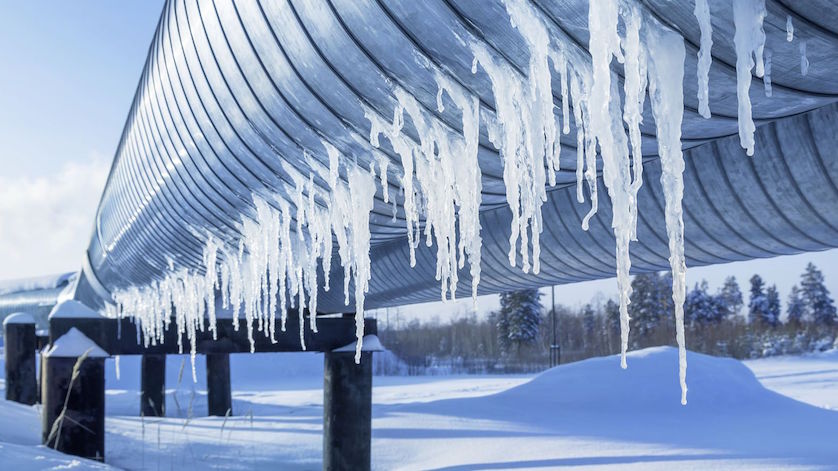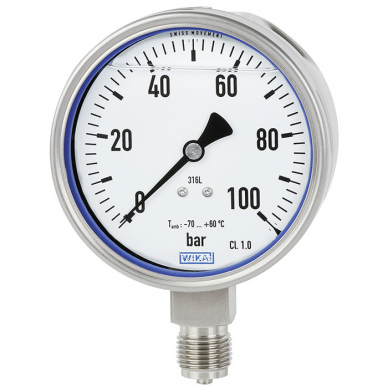
Most pressure gauges work in ambient temperatures as low as −40°F (−40°C). However, around the Arctic Circle, the norm is below −40°F, which is too extreme for conventional pressure gauges to handle. Model PG23LT from WIKA is a high-performance liquid-filled pressure gauge specifically designed for ambient temperatures down to −94°F (−70°C).
A pressure gauge subjected to extremely low ambient temperatures requires a liquid-filled case, as the liquid filling prevents moisture from forming inside the case. Moisture inside the case can cause moving parts to freeze over, thus preventing the pointer from moving. Moisture can also form behind the window, causing it to fog up or, in extreme conditions, to frost over. Either form of moisture prevents a technician from reading the instrument.
Another benefit of the liquid case filling is that it lubricates the internal mechanisms, which extends the life of the pressure gauge when it’s exposed to vibrations, and reduces or eliminates pointer flutter.
Chilly Problems with Standard Liquid-Filled Pressure Gauge
For cold weather use, the oil and gas industry relies on pressure gauges filled with silicone oil. However, this solution is only good for temperatures −40°F (−40°C) and above. Below that, the fill liquid becomes too viscous, resulting in slower response times and inaccurate pressure readings. In extreme cold, the case fill begins to solidify and the gauge might stop working altogether.
That’s why WIKA’s Model PG23LT comes with a special low-temperature silicone case fill, to ensure accurate readings even at extremely low temperatures.
The fill liquid isn’t the only consideration, though. Another critical component to a hermetically sealed and liquid-filled pressure gauge is the elastomers. O-rings and gaskets prevent 1) moisture from entering the case and 2) the case fill from leaking out. Flat gaskets are used to seal the window, the blow-out back at the rear of the case, and the vent valve on top of the case for pressure compensation.
Standard sealing materials, however, will not withstand very low ambient temperatures. Over time, they become brittle and lose their sealing properties. When developing the PG23LT, WIKA engineers eliminated elastomers at critical points. The window seal and O-ring to seal the blow-out back are made from a special material that can withstand extremely low temperatures. The fill plug, normally made of rubber, has been replaced with a stainless steel hex screw or compensating valve, depending on the pressure range.
Model PG23LT: Cool Running in Extremely Low Temperatures

WIKA’s Model PG23LT: a Bourdon tube pressure gauge specially designed to perform well in ambient temperatures as low as −94°F (−70°C).
The PG23LT comes in ranges from 0…10 psi (0.6 bar) up to 0…15,000 psi (1,000 bar). The standard enclosure rating is IP65 per EN/IEC 60529 for pressure ranges up to 230 psi (16 bar) and IP66/IP67 (NEMA 4/4X) for ranges 300 psi (20 bar) and up.
For safety critical applications, the gauge is available in safety design “S3” per EN 837-1 with a blow-out back and a solid baffle wall separating the gauge internals from the window. The PG23LT is supplied with a Certificate of Compliance (2.2 test report) to confirm its suitability for ambient temperatures down to −94°F (−70°C). If needed, the PG23LT can be supplied with industry approvals such as ATEX. EAC and metrology approvals for export into CIS (Commonwealth of Independent States) countries are also available. Overall, WIKA’s PG23LT is the best solution for all applications in extreme low ambient conditions.
Choosing the right liquid-filled pressure gauge to fit the particular conditions of your application will ensure that your process works properly. Contact WIKA’s experts for help in finding the instrumentation that will maximize your processes’ performance and safety.


Hello wika.us administrator, You always provide helpful information.
Please information pressure gauge type for -45 C with connection clamp ferrule 1.5″ mat full stainless, application for cold brine
Dear Asep,
Thank you for your interest in our blog. Assuming that you are referring to a -45 C process temperature, our recommendation would be a gauge with diaphragm seal assembly. The important thing is that the correct system fill (transmission liquid) is picked based on the temperature.
Please contact your nearest WIKA representative and provide all specifications. I am sure that we can provide you with a solution that will work for you.
Best regards,
Hardy Orzikowski
I am looking for a pressure gauge for liquid nitrogen service with the following spec: 0-300 psig, ½” npt, 4.5” dial size, lower mount. Would this gauge be the right selection for this process?
Hi, Ryan. Your product inquiry has been passed along to our pressure gauge product manager. He should be reaching out to you shortly if he has not already done so. Also, feel free to fill out a contact form on our contact page.